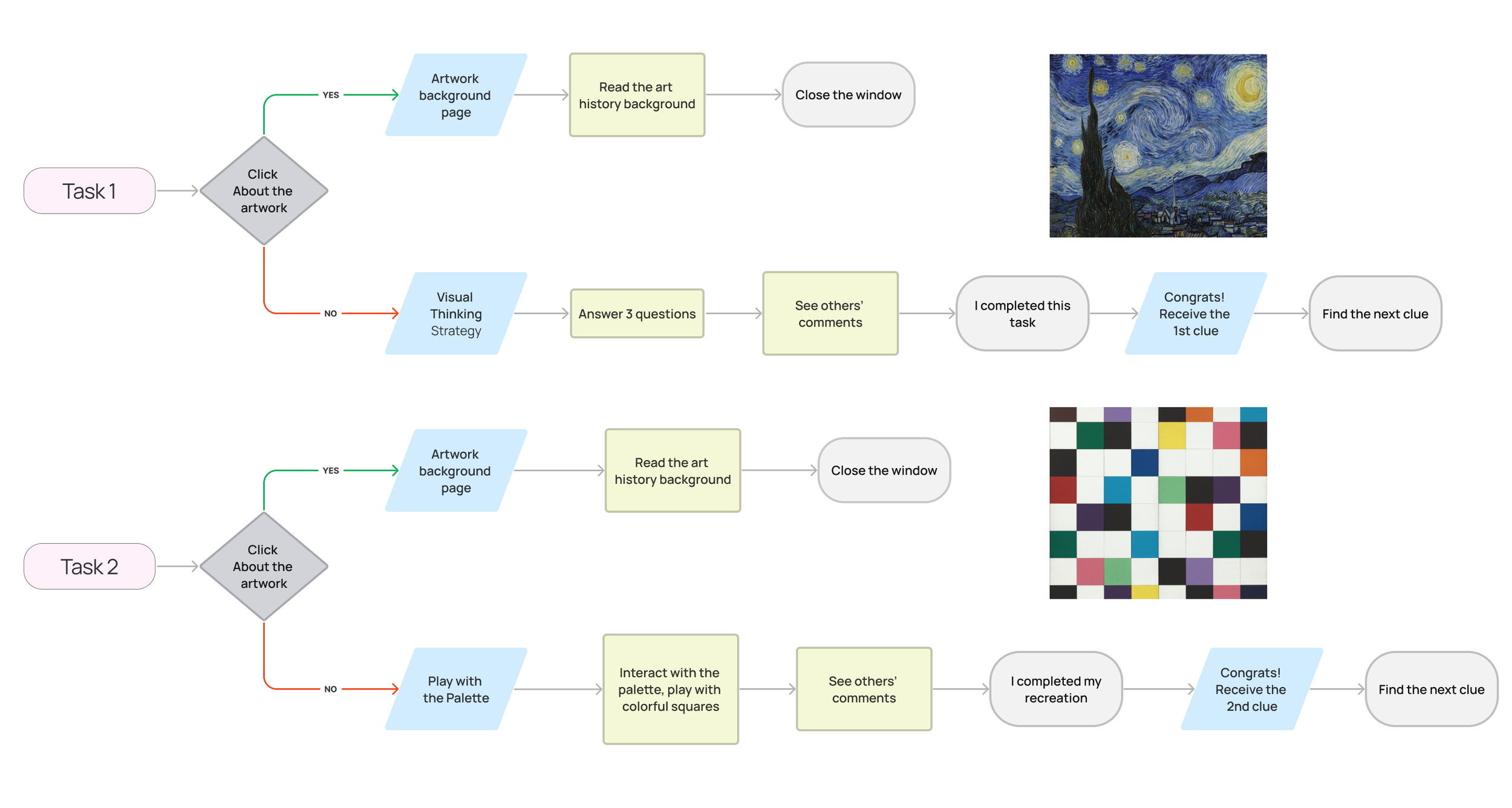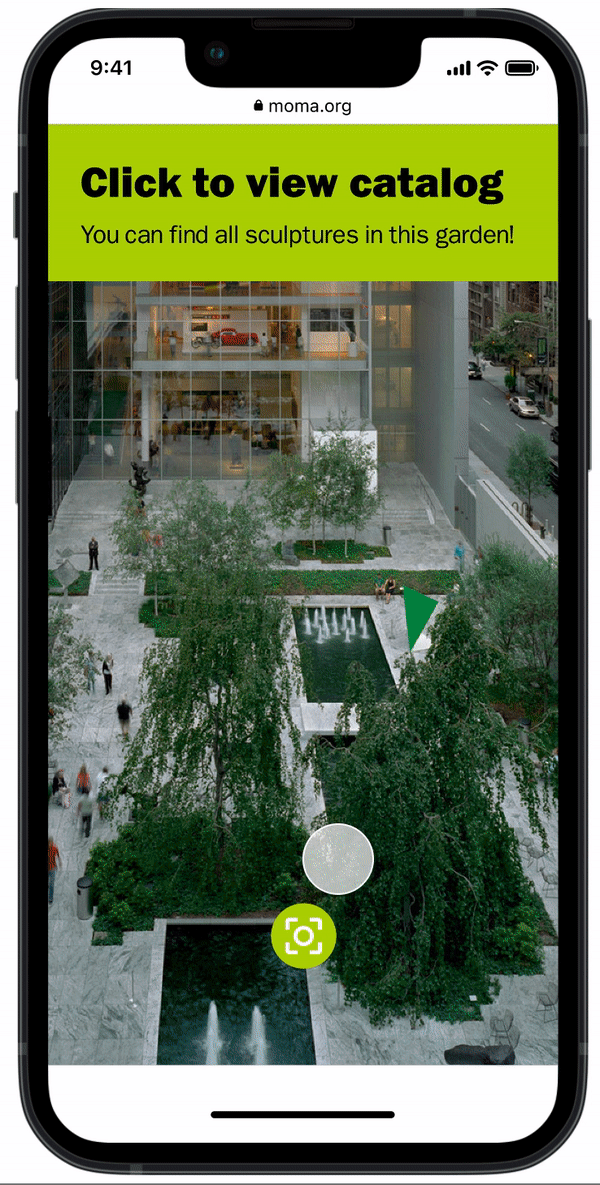Problem Statement
The problem addressed in this UX design project is how to enhance museum experiences for young adults by incorporating mobile gamification.
The major research question is: "How can mobile gamification be leveraged to improve young adults' comprehension and enjoyment of art in museums?"
The current digital MoMa museum guide falls short in terms of meaningful audience engagement, limited awareness of educational resources, and unclear routes for visitors to access significant artworks or famous sites at MoMa. Additionally, existing in-person museum education programs require digital transformation.
Possible Solution
The possible solution is to use treasure hunting game and thematic art tours to guide visitors to have more engaging artistic experiences at MoMA. Our new design will transform in-person museum education curriculum to digital forms and build up an online art community for socialization. The creative artmaking feature will encourage audiences to interact more profoundly with artworks at MoMA.
Design Thinking Process
Emphasize
Field Observation
In order to discover the real application and feedback of the current MoMA digital tour guide, we went to the museum for field observation and took many meaningful notes. We discovered that visitors often overlook education activities and art tours in the patio gardens.
Current MoMA Digital Visitor Guide
We found the following problems with the current MoMA digital guide through field observation research.
The functions of maps, voice guidance, and the current exhibition are all separate, and users are very annoyed when clicking on them one by one.
The exhibitions are arranged through the timeline of art history, such as "Collection 1940s", which is very complex for users without knowledge of art history.
It is easy for users to miss out on the art and educational activities of museums, and they will not actively participate in these activities.
Users do not know how to plan their route to view artworks using the current navigation map.
User Interview
We used qualitative research with the approach of interviews to obtain in-depth feedback. We asked four interviewees the following questions…
Define
Competitor Analysis
The Competitive Analysis evaluates the existing functions of other NYC museum digital guides. Based on the analysis, it is potential for us to incorporate new features of the thematic tour, artmaking, significant art route, online comments, and artwork up.
User Persona
Our user persona for the MoMA digital guide redesign is a college student in New York City who is interested in art and wants to enhance their museum experience. Meet Lucy, a 20-year-old mathematics major who loves exploring museums but often feels overwhelmed by the amount of information available.
User Journey Map
We use the user journey map to visually represent the steps, emotions, pain points, and opportunities that a user may have during art tours at the MoMA museum. It will help us understand the college students' experience, from the moment they start planning their visit to the moment they leave the museum.
User Pain Points
Based on the user interviews, on-site observations, analysis of the existing MoMA product, persona, and user journey maps, we have summarized the following user pain points.
Literature Review
In order to understand the current development and application of mobile learning experiences in art museums, we conducted in-depth research and wrote a literature review, investigating scholars' views and published examples on gamification and digital transformation of museum education.
Ideate
Card Sorting
We use the card sorting method to better understand how users may categorize information and organize it into groups. This process helps us to gain insight into users' potential using models and organize four major themes: gamification, creative art-making, museum education, and socialization.
Information Architecture
On top of the original Moma digital tour, we have added an additional option: Creative Art Tour, which allows users to choose between traditional official content or gamified new experiences.
User Flow
Before designing the high-fidelity prototype, we first listed the complete user flow so that we could more clearly design each interactive experience process, including buttons, selections, user actions, and art learning activities that will be included.
Design Solution
Based on the design thinking strategy, in the Ideate phase, we generate design solutions after a series of user research, pain points exploration, and literature review. They are categorized into 6 design directions: game-based learning, personalized learning, transform museum education pedagogies, constructivism, socialization, and thematic art tours.
Prototype
Task 1 Digital Visual Thinking Strategy
Engage with the Visual Thinking Strategies on our digital tour, which is broadly used in face-to-face museum art education programs.
Share comments about artworks with the online MoMA art community.
View art history information that is longer than the annotations on the museum wall.
Task 2 Rearrangement
Interact with the artwork, deeply exploring the color, composition, and form.
Engage with the artwork in the form of playing mobile games.
Immerse in a treasure-hunting game, searching for artworks and gaining clues for the next stop.
Task 3 Interactive Art History Learning
Enlarge key painting details on the canvas.
Searching for the inspiration source of Picasso's creation through reading art history.
Don't miss out on any important visual content and storyline on the canvas, following the assigned learning steps.
Task 4 Digital Painting
Follow the artistic style of the master artist Jackson Pollock to create individual abstract artworks.
Explore digital painting and artistic expressions on the mobile, experimenting with the effects of different brushes and color combinations.
Task 5 Exploring the Sculpture Garden
Help users explore iconic sites, and don't miss out on the wonders of MoMA architecture.
Guide users to discover and find sculpture artworks in the garden.
Share individual artistic journey with more social media users
Testing

























